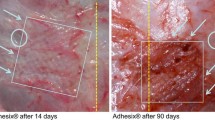Abstract
Introduction
Use of adhesives for mesh fixation in hernia is increasing. There has been minimal study of mesh incorporation and interface strength with adhesive fixation for ventral hernia repair. The purpose of this study was to evaluate the fixation properties of fibrin glue as it compared to suture fixation of mesh in an onlay position.
Methods
Twenty-four mongrel pigs were divided into three study arms based on time points for biomechanical evaluation: 24 h (n = 8), 7 days (n = 8), and 14 days (n = 8). Initial procedures included placement of two 4 × 6 cm pieces of wide-pore polypropylene mesh in an onlay position. One was fixated with 4 ml of fibrin glue and the other with four interrupted 2-0 polypropylene sutures. The shear strength of fixation was evaluated using a uniaxial testing device along with histological evaluation. Maximum force was normalized by the width of the mesh.
Results
Mesh–tissue interface of glued and sutured specimens at 7 and 14 days did not fail in our testing configuration. Only at the 24-h time point the mesh detached from the tissue, and the sutured interface (10.4 N/cm) was significantly stronger than glued interface (4.9 N/cm, p = 0.004). Histopathologic and gross evaluations of the specimens revealed similar histologic features at all time points for both glued and sutured specimens.
Conclusions
With mesh in the onlay position, fixation to the abdominal wall occurs quickly. Though sutures were stronger at 24 h, as early as 1 week, the strength of the fixation exceeded the tissue or the mesh strength in our testing configuration for both glue and suture groups. Fixation strength is independent of technique at the latter time points. There are potential clinical advantages to the exclusive use of fibrin glue for fixation including acute post-operative pain, chronic post-operative pain, and recurrence for ventral incisional hernia repair.







Similar content being viewed by others
References
Campanelli G, Pascual M, Hoeferlin A et al (2012) Randomized, controlled, blinded trial of Tisseel/Tissucol for mesh fixation in patients undergoing Lichtenstein technique for primary inguinal hernia repair: results of the TIMELI trial. Ann Surg 255:650–657
Clarke T, Katkhouda N, Mason J et al (2011) Fibrin glue for intraperitoneal laparoscopic mesh fixation: a comparative study in a swine model. Surg Endosc 25:737–748
Schug-Pass C, Lippert H, Kockerling F (2009) Fixation of mesh to the peritoneum using a fibrin glue: investigations with a biomechanical model and an experimental laparoscopic porcine model. Surg Endosc 23:2809–2815
Chevrel JP, Rath AM (1997) The use of fibrin glues in the surgical treatment of incisional hernias. Hernia 1:9–14
Kingsnorth A, Shahid M, Valliatu A et al (2008) Open on lay mesh repair for major abdominal wall hernias with selective use of components separation and fibrin sealant. World J Surg 32:26–30
Canziani M, Frattini F, Cavalli M, Agrusti S et al (2009) Sutureless mesh fibrin glue incisional hernia repair. Hernia 13(6):625–629
Licheri S, Erdas E, Pisano G et al (2008) Chevrel technique for midline incisional hernia: still an effective procedure. Hernia 12:121–126
Schwab R, Schumacher O, Junge K et al (2006) Fibrin sealant for mesh fixation in lichenstein repair: biomechanical analysis of different techniques. Hernia 11:139–145
Schug-Pass C, Dietmar A, Lippert H (2012) Differences in biomechanical stability using various fibrin glue compositions for mesh fixation in endoscopic inguinal hernia repair. Surg Endosc (epub ahead of print)
Jenkins E, Melman L, Deeken C et al (2010) Evaluation of fenestrated and non fenestrated biologic grafts in a porcine model of mature ventral incisional hernia repair. Hernia 14:599–610
Valentin JE, Badylak JS, McCabe GP, Badylak SF (2006) Extracellular matrix bioscaffolds for orthopaedic applications. A comparative histologic study. J Bone Jt Surg Am 88:2673–2686
Gruber-Blum S, Petter-Puchner A, Mika K et al (2010) A comparison of a bovine albumin/glutaraldehyde glue versus fibrin sealant for hernia mesh fixation in experimental onlay and IPOM repair in rats. Surg Endosc 24:3086–3094
Conflict of interest
N. Stoikes has a research grant with Bard Davol. G. Voeller consults with Gore, Bard Davol, and Covidien. All other authors have no conflict of interest.
Author information
Authors and Affiliations
Corresponding author
Rights and permissions
About this article
Cite this article
Stoikes, N., Sharpe, J., Tasneem, H. et al. Biomechanical evaluation of fixation properties of fibrin glue for ventral incisional hernia repair. Hernia 19, 161–166 (2015). https://doi.org/10.1007/s10029-013-1163-y
Received:
Accepted:
Published:
Issue Date:
DOI: https://doi.org/10.1007/s10029-013-1163-y




